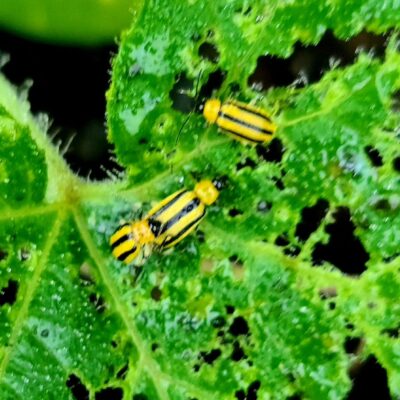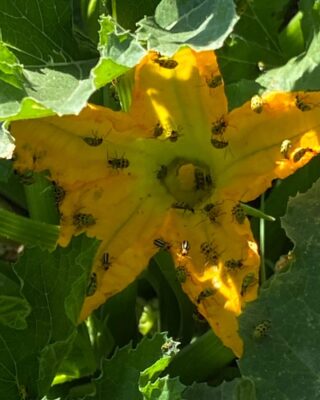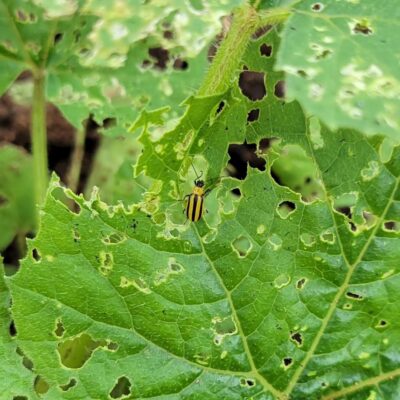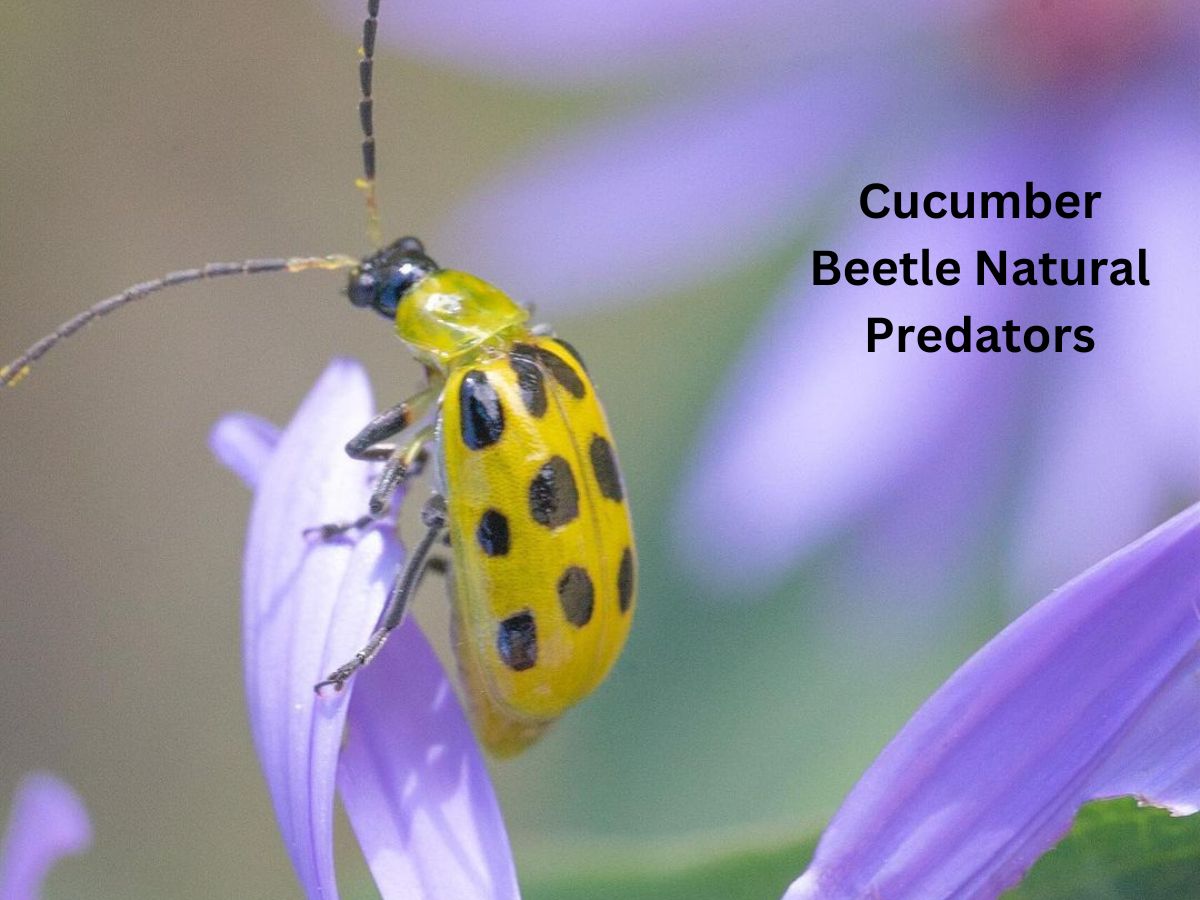In the world of gardening, where pests often test our green thumbs, a secret army of defenders quietly awaits – cucumber beetle natural predators. These tiny warriors, often overshadowed by their peskier counterparts, are the unsung heroes of our garden’s delicate balance. Picture this: ladybugs patrolling leaves, parasitic wasps executing tactical strikes, and ground beetles stealthily on the prowl.
These natural allies are the answer to the perennial question: “How do I fend off those persistent cucumber beetles?”
As gardeners, we’ve all faced the frustration of battling cucumber beetles, those voracious leaf-munchers that threaten our hard-earned harvest. But fear not, for this article unveils the champions of pest control that nature has provided.
They’re not just insects; they’re guardians of our green havens. From the sunflowers that sway to their buzz, to the marigolds that whisper to ladybugs, we’ll explore the intricate web that links these predators to our gardens.
So, if you’re tired of waging war against cucumber beetles, it’s time to enlist nature’s elite squad. In this article, we’ll journey through the lives and feats of these stealthy protectors, revealing the strategies they employ to keep your garden thriving and pest-free. Prepare to be captivated by the underappreciated heroes of your garden – the cucumber beetle natural predators.
What are the Cucumber Beetles?
That’s the cucumber beetle – a tiny yet formidable adversary that can wreak havoc on your garden. There are two primary types: the striped Acalymma species and the spotted Diabrotica variety.
These crafty infiltrators may differ in appearance, but their mission is the same: to dine on your precious plants. From cucumbers to melons and squash, no crop is safe from their insatiable appetite. But their destructive tendencies don’t end at the surface.
Cucumber beetles have the uncanny ability to transmit diseases as they feast, leaving a wake of wilted leaves, stunted growth, and diminished yields. It’s a garden drama that unfolds every season, making the need to understand and combat these voracious pests all the more urgent.

What damage do cucumber beetles cause?
Cucumber beetles are notorious garden troublemakers, causing a range of damages that can severely impact your plants and crops. Here’s a breakdown of the havoc they can wreak:
- Feeding on Foliage: One of the most visible and immediate signs of cucumber beetle damage is feeding on plant foliage. Adult beetles, as well as their larvae, munch on leaves, leaving behind a telltale skeletonized appearance. This type of feeding weakens the plants and reduces their ability to perform photosynthesis, which is crucial for growth and fruit development.
- Transmitting Diseases: Cucumber beetles aren’t just voracious eaters; they can also act as disease vectors. As they feed, they can introduce harmful pathogens into your plants. For instance, they’re known to transmit bacterial wilt, a devastating disease that can cause rapid wilting and death in plants like cucumbers, melons, and squash.
- Damaging Flowers and Fruits: Cucumber beetles aren’t content with just the leaves; they’ll happily nibble on flowers and fruits too. This can lead to deformities, reduced fruit set, and even rotting. The result? A significant drop in yield and poor-quality produce.
- Stunted Growth: The combined effects of feeding, disease transmission, and general stress can lead to stunted plant growth. Your plants might struggle to reach their full potential, resulting in smaller and less productive harvests.
- Economic Loss: Beyond the garden, cucumber beetle damage can have economic implications for farmers and growers. Reduced crop yields and poor-quality produce can lead to financial losses, impacting livelihoods and food supplies.
- Persistent Populations: If not properly managed, cucumber beetle populations can explode, leading to even more extensive damage. These pests are known for their ability to reproduce rapidly, making early detection and intervention crucial.
- Impact on Other Crops: While cucumber beetles prefer cucurbit plants (cucumbers, melons, squash), they’re not picky eaters. They can infest other plants as well, causing damage to a broader range of crops in your garden.
To minimize the potential damage caused by cucumber beetles, it’s important to implement effective pest management strategies that include fostering natural predator populations, practicing crop rotation, and considering resistant plant varieties. Early detection and intervention are key to keeping these troublesome pests in check and ensuring a bountiful and healthy garden.
Cucumber beetle natural predators
In the fascinating world of garden warfare, cucumber beetle natural predators are the unsung heroes that come to the rescue when these pesky pests strike. Let’s meet the guardians of your greenery:
- Ladybugs: Don’t let their dainty appearance fool you – ladybugs are fierce defenders of your garden. These charming beetles have an insatiable appetite for aphids, mites, and even cucumber beetles. A single ladybug can consume an impressive number of these pests in a day, making them a vital ally in your fight against cucumber beetle infestations. Their vibrant colors and gentle demeanor add a touch of wonder to your garden while they work tirelessly to keep the pest population in check.
- Parasitic Wasps: Prepare to be amazed by nature’s craftiness. Parasitic wasps, though tiny, pack a mighty punch in the battle against cucumber beetles. These wasps lay their eggs on the backs of adult beetles. As the wasp larvae develop, they feed on the cucumber beetles from the inside, eventually leading to their demise. It’s a gruesome yet awe-inspiring example of nature’s intricate balance.
- Ground Beetles: When darkness falls, ground beetles emerge as stealthy garden defenders. These nocturnal hunters patrol the soil, feasting on an array of pests including cucumber beetles. Their dedication to the night shift helps maintain a healthier garden ecosystem. By creating habitats that mimic their natural environment, you can encourage these beetles to stick around and keep watch over your plants.
- Birds: Take a moment to appreciate the birds that grace your garden with their presence. Some bird species, like sparrows, blackbirds, and starlings, view cucumber beetles as scrumptious snacks. With their keen eyesight and nimble beaks, these feathered friends help control pest populations. To invite them to your garden, provide bird-friendly features like feeders and water sources.
- Wolf Spiders: These eight-legged allies are often overlooked for their pest-control prowess. Wolf spiders, with their intricate webs and stealthy tactics, catch a variety of insects, including cucumber beetles. They contribute to maintaining a balanced garden ecosystem by reducing pest numbers. Encourage spiders by providing them with sheltered spots to weave their webs.
- Minute Pirate Bugs: Tiny yet mighty, minute pirate bugs are inconspicuous but effective cucumber beetle predators. These minuscule insects have a penchant for feeding on the eggs and larvae of various pests, including cucumber beetles. Their contribution may be small in size, but it’s impactful in maintaining a pest-free garden.
- Tachinid Flies: In the ongoing drama of the garden, tachinid flies play a unique role. These flies lay their eggs on cucumber beetles, and when the fly larvae hatch, they burrow into the beetles and feed on them from within. While it might sound like something out of a horror movie, it’s a natural control mechanism that helps keep cucumber beetle populations in check.
- Predatory Nematodes: Beneath the soil’s surface, another set of allies is at work. Predatory nematodes are microscopic worms that seek out and parasitize various soil-dwelling pests, including cucumber beetle larvae. They provide a silent yet effective form of pest management, contributing to a healthier root environment for your plants.
- Assassin Bugs: Assassin bugs are the vigilantes of your garden, preying on a variety of pests, including cucumber beetles. Armed with a long proboscis, they inject enzymes into their prey, liquefying their insides for easy consumption. While their methods might be intense, they’re efficient at controlling pest populations.
- Frogs and Toads: Beyond the world of insects, amphibians like frogs and toads also play a role in pest management. These hopping heroes have a hearty appetite for insects, including cucumber beetles. By creating a welcoming environment with water sources and shelter, you can encourage these garden allies to take up residence and lend a helping hand.
- Green Lacewings: With their delicate appearance and lacy wings, green lacewings might seem too fragile to be effective predators. However, these insects are formidable hunters in the world of pests. Both adult lacewings and their larvae feed on aphids, mites, and cucumber beetles. By releasing green lacewings into your garden, you can harness their appetite for your benefit.
- Soldier Beetles: Soldier beetles are the infantry of your garden’s defense force. These beetles are generalist predators, meaning they consume a wide range of pests, including cucumber beetles. They’re attracted to flowers like goldenrod and yarrow, making them a valuable asset to pollinator-friendly gardens.
- Dragonflies and Damselflies: Hovering above your garden, dragonflies and damselflies aren’t just breathtaking aerial acrobats – they’re also opportunistic predators. These insects have a taste for small flying insects, including cucumber beetles. By maintaining a water source in your garden, you can attract these elegant hunters and benefit from their pest-controlling prowess.
- Robber Flies: Robber flies might not have the flashy appearance of some other insects, but they’re top-tier predators in the bug world. With their strong flying ability, they snatch insects, including cucumber beetles, out of mid-air. These flies exhibit both speed and stealth as they contribute to reducing pest populations.
- Praying Mantises: Praying mantises are the quintessential insect assassins. Their iconic posture and quick reflexes make them skilled predators. While they might not focus exclusively on cucumber beetles, they’re efficient hunters that contribute to maintaining a balanced ecosystem in your garden.
- Hedgehogs and Small Mammals: In some environments, small mammals like hedgehogs play a role in controlling pest populations. These spiky allies have a varied diet that includes insects, making them potential cucumber beetle hunters. If you have a garden with a diverse range of creatures, you might find these critters contributing to pest management.
By harnessing the power of these diverse natural predators, you’re not only creating a healthier garden but also participating in a natural dance of life where each creature plays its part. Remember that attracting and maintaining a variety of these allies involves creating a garden habitat that caters to their needs – be it shelter, food sources, or water.

Attracting and Supporting Natural Predators
Creating an ecosystem that welcomes and supports natural predators is the key to a thriving garden that can naturally fend off cucumber beetles and other pests. Here’s how you can make your garden a haven for these helpful allies:
- Plant Pollen-Rich Flowers: Flowers aren’t just pretty; they’re beacons for beneficial insects. Plant a variety of pollen and nectar-rich flowers such as marigolds, zinnias, sunflowers, and daisies. These blooms attract ladybugs, bees, parasitic wasps, and other predators, providing them with the sustenance they need to thrive.
- Embrace Diversity: A diverse garden ecosystem is a healthy one. Incorporate a mix of plant types, sizes, and structures. This diversity attracts a range of predators, as different species have varying needs for food and shelter.
- Provide Shelter and Hiding Spots: Natural predators need places to rest, reproduce, and seek refuge from harsh weather. Create habitats like rock piles, mulch beds, and even small patches of tall grass where they can hide, lay eggs, and raise their young.
- Limit Pesticide Use: Pesticides can harm both pests and predators. If you want to foster a thriving predator population, minimize or eliminate the use of chemical pesticides. Instead, opt for organic and targeted pest control methods that won’t disrupt the balance you’re trying to achieve.
- Incorporate Water Sources: Water is essential for life, and natural predators are no exception. Consider adding shallow dishes of water or a small pond to your garden to provide a refreshing drink for these helpful insects and creatures.
- Avoid Over-Cleaning: While garden tidiness is important, leaving some leaf litter and plant debris can provide shelter and overwintering spots for predators. A balance between cleanliness and a bit of wildness can be beneficial.
- Time Your Plantings: Planting strategically can attract specific predators when they’re needed most. For example, planting flowers that bloom early in the season can attract beneficial insects at a time when pest populations might be on the rise.
- Use Companion Plants: Certain plants repel pests or attract predators. For example, planting mint, dill, and fennel can help attract beneficial insects like parasitic wasps and ladybugs.
- Rotate Crops: Cucumber beetles can be deterred by rotating your crops each season. This prevents them from building up large populations in the same location year after year.
- Be Patient: Creating a balanced ecosystem takes time. Be patient as you observe how different predators respond to your efforts. Over time, you’ll notice a healthier garden with reduced pest issues.
By focusing on these strategies, you’re not just creating a garden – you’re crafting a thriving ecosystem where the delicate dance of predator and prey maintains harmony. As you nurture your plants, you’ll also be nurturing a community of natural allies that contribute to your garden’s health and beauty.
Cucumber beetle natural predators FAQs?
Are natural predators more effective than chemical pesticides?
Absolutely, natural predators offer a sustainable and long-term solution for managing pest populations in your garden. Unlike chemical pesticides that might provide quick relief, natural predators are part of a holistic approach that maintains the delicate balance of your garden’s ecosystem.
Chemical pesticides can often disrupt this balance by harming not only the target pests but also beneficial insects, including pollinators and other natural predators. Over time, some pests can develop resistance to chemicals, making them less effective.
Natural predators, on the other hand, actively seek out and consume pests, helping to control their populations naturally. This approach reduces the risk of pest resurgence and minimizes the need for repeated pesticide applications.
By fostering a diverse range of natural predators, you’re establishing a self-regulating system that’s better equipped to handle pest challenges without causing harm to your garden’s overall health.

How can I identify the presence of natural predators in my garden?
Observing the activity of natural predators in your garden can be both fascinating and rewarding. Here’s how you can spot their presence:
- Larvae and Adults: Look for the larvae and adult forms of beneficial insects like ladybugs, lacewings, and parasitic wasps. These creatures are often found on plants, hunting for prey.
- Nesting Sites: Check for signs of nesting or egg-laying. For instance, parasitic wasps lay eggs on or inside pest insects, while ground beetles often lay eggs in soil.
- Pupal Stage: Some predators, like ladybugs, undergo a pupal stage before emerging as adults. Keep an eye out for these pupal cases attached to leaves or stems.
- Predator Activity: Watch for behaviors like predation – natural predators actively hunting and feeding on pests.
- Droppings: Predatory insects often leave behind telltale signs, such as discarded exoskeletons or pest remains.
- Birds and Other Creatures: Observing birds, spiders, frogs, and other creatures hunting in your garden is another indicator of a healthy predator population.
Remember, the presence of natural predators might not completely eliminate pest populations, but it should help keep them in check and prevent large outbreaks.
What are some common flowers that attract beneficial insects?
Several flowers are well-known for their ability to attract beneficial insects. These flowers provide essential pollen and nectar sources that sustain predators and pollinators alike. Some common choices include:
- Marigolds: Their bright colors and distinct scent attract ladybugs, lacewings, and parasitic wasps.
- Zinnias: Zinnias offer a feast for butterflies, bees, and parasitic wasps.
- Sunflowers: These towering beauties draw in a wide range of pollinators and predators.
- Alyssum: With its delicate blooms, alyssum attracts hoverflies, lacewings, and ladybugs.
- Fennel and Dill: These herbs not only enhance your culinary delights but also attract parasitic wasps and other beneficial insects.
Do natural predators pose any risks to my plants?
Generally, natural predators are highly targeted in their hunting and feeding habits. They tend to focus on pest insects and larvae rather than plants. However, it’s important to note that in their pursuit of prey, natural predators might inadvertently cause some minor damage to plants. For example, ladybug larvae can sometimes consume small amounts of plant material as they search for aphids.
While this might be a concern, the benefits of having natural predators far outweigh the potential minor plant damage. The key is to strike a balance – a few nibbled leaves are a small price to pay for the valuable service these predators provide in managing pest populations.
Monitoring the predator-to-pest ratio and ensuring your garden is rich in diverse food sources can help maintain a harmonious relationship between natural predators and your plants.
Conclusion
As we bid farewell in this journey through the realm of cucumber beetle natural predators, it’s clear that nature’s defenders are the unsung heroes of your garden. From the charming ladybugs to the strategic parasitic wasps, these allies work in harmony to safeguard your plants from the relentless onslaught of cucumber beetles.
By creating a welcoming habitat that supports these predators, you’re not only cultivating a garden of beauty but also nurturing a thriving ecosystem.
Embracing these natural solutions isn’t just about pest control; it’s a commitment to a sustainable and balanced approach to gardening. As you witness the delicate dance of predator and prey, you’re contributing to the intricate web of life that sustains us all.
So, let your garden flourish under the watchful gaze of these mighty defenders, and remember that in this world of gardening, harmony and balance truly reign supreme.
